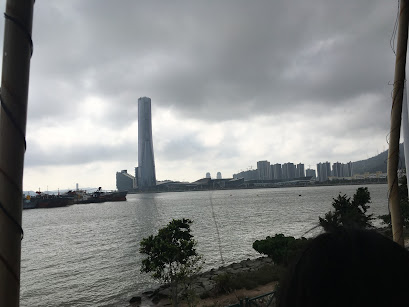Historically speaking, the Far East has been a religiously complex place. The area was extremely international, hosting a profitable trade economy that imported goods from many different countries. The people who imported these goods also brought their home religion with them, and, for the most part, were well-received. This was especially true in China; traditional Chinese religions or philosophies never claimed to be exclusive, so the Chinese were historically open to incorporating foreign religions into their own religion.
In the
1600's, the Jesuit order (an order of monks famous for their mission and educational work--they founded a load of colleges) were very present in the Far East, and Macau was the center of their operations. (They weren't the first Europeans there, however, contrary to that article--Marco Polo was there long before the Jesuits were founded).
Central to Macau was the beautiful
Church of St. Paul.
St. Paul (seriously, Blogger, fix your formatting issues with the new template!) was built in the 16th century, but caught fire 3 different times and was not rebuilt after the last time. I remember chatting with a professor who said that it was built by Japanese Christians escaping persecution from persecution in Japan, but all I could find related to that was
this article, which just says the cathedral holds their relics.
This is definitely one of the most famous single spots in Macau, and we visited here first.
First, the ruins are located on the Rua de Ressurreicao, or the Street of the Resurrection. In order to get there, we first had to walk down the Rua de Ressurreicao.
Simple, right?
Not really.
(Seriously, why does it hyperlink whenever I hit "enter" after a photo?! Blogger!!)Macau is the single most crowded place on the planet. Of the regions in the world (not cities, but regions), it has the
highest population density of the entire world, with more than 21,000 people per square kilometer. As if that wasn't bad enough, because we were there during Chinese New Year, people were here on vacation. (See, in Shenyang, they tell us that people go home for Chinese New Year. Clearly, people also meet up with their families to go on vacation.) In 2019, over the two weeks of Chinese New Year,
more than 1 million people visited! To top it off, we didn't notice any subways, so everyone is packed together on the streets above ground.
It took us something like 45 minutes to walk the Rua de Ressurreicao.
(Holy smokes, Blogger, you're just turning all the pictures into hyperlinks?! Knock it off!)
Once we got there, though, we had a great time enjoying the beautiful ruins.
 |
| It's hard to tell, but right above the square door are the words "Mater Dei", which means "Mother of God". This intrigued me because the first Christians to reach the Far East were actually Nestorian Christians, who--if I'm remembering Professor Finnigan's lectures correctly--did not call Mary the mother of God, but just called her the "Mother of Christ". The simple version, if I remember correctly, is that during the 4th century, Church Fathers were debating whether to call Mary "Mother of God" (theotokos) or "Mother of Man" (something I can't remember). Nestorius decided to solve the problem by just calling her "Mother of Christ", which was a problem because that didn't address the real question of Christ's human-divine nature. Nestorius was exiled to the east of the Roman Empire, and his teachings eventually worked their way into the Orient long before even Marco Polo. Anyway, long story short, this is definitely not a Nestorian church. |
 |
|
 |
These are windows into the archaeological parts of the church. I think these were the pillars that supported the walls before they burned down.
|
Underneath the ruins is the crypt and the Museum of Sacred Art. This had paintings and statues, of course, but it also held items such as engraved communion chalices, clerical garments, and other items that are both used and beautiful. I remember a few coming from other parts of Asia.
However, I only took one picture:
 |
I should have done this sooner... but if I remember correctly, this is a statue of St. Augustine. I have no idea which church he's holding... it looks nothing like St. Peter's Basilica in Rome, but it does look a little like Notre Dame. Maybe it's the the Lisbon Cathedral? I don't remember.
|
ARE YOU KIDDING, BLOGGER! When I tried to center all my photos, it just completely rearranged everything I'd written!
(And now it won't let me log into my YouTube account so I can insert the video I took of this post when it was all jumbled up.)
Anyway, that was St. Paul's Cathedral in Macau. If you want to visit China, but you don't want to go through the process of getting the tourist's 10-year visa, you can definitely visit Macau and see St. Paul's (because Macau doesn't require visas). It was well worth the visit.
The next place we went to was... not a church.





























